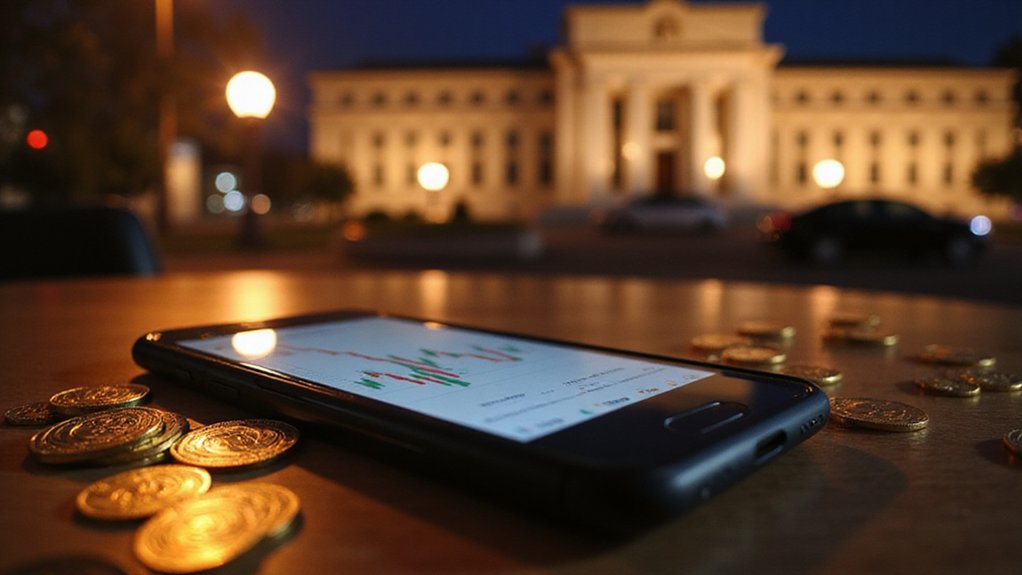Trust Wallet functions as a decentralized mobile cryptocurrency wallet that stores private keys locally on users’ devices—a remarkably straightforward approach in an industry obsessed with custody battles. The platform supports over 100 blockchains and 10 million digital assets while providing direct access to decentralized applications and DeFi protocols. Users maintain complete control over their holdings through robust encryption and recovery phrase backups, though one wonders if they truly grasp the implications of self-sovereignty in practice.

While the cryptocurrency ecosystem continues its relentless march toward ever-greater complexity—spawning countless tokens, protocols, and blockchain networks that would make even seasoned financial professionals reach for aspirin—Trust Wallet emerges as a decidedly pragmatic solution to the multi-chain management problem that plagues digital asset holders.
This decentralized, non-custodial mobile wallet operates on the invigoratingly straightforward principle that users should actually control their own assets (a concept apparently revolutionary in an era where most people cheerfully surrender their financial sovereignty to centralized platforms). Trust Wallet stores private keys locally on users’ devices, employing robust encryption and recovery phrase backups while maintaining a zero personal tracking policy that would make privacy advocates weep with joy.
The wallet’s multi-asset architecture supports over 100 blockchains and 10 million crypto assets, accommodating everything from Bitcoin and Ethereum to the latest meme coins that somehow command billion-dollar valuations. This all-encompassing compatibility extends to NFTs, because apparently digital receipts for pixelated artwork constitute a legitimate asset class worthy of portfolio inclusion.
Perhaps more intriguingly, Trust Wallet functions as a Web3 gateway, providing direct access to decentralized applications, DeFi protocols, and NFT marketplaces without requiring users to traverse the Byzantine process of connecting external wallets. The integrated decentralized exchange facilitates peer-to-peer token swaps, eliminating centralized intermediaries while leveraging multiple liquidity sources for competitive pricing—a feature particularly valuable given the notorious volatility spreads that characterize crypto markets. This approach aligns with the broader DeFi ecosystem goal of removing trusted third parties and enabling direct interaction between users through blockchain-based smart contracts.
The platform’s staking capabilities allow users to earn passive income on select cryptocurrencies directly through the wallet interface, streamlining what traditionally required multiple platform interactions. Users can utilize the wallet’s biometric authentication features to add an extra layer of security beyond traditional password protection. Smart contract integration enables seamless participation in DeFi protocols, though users presumably understand the risks inherent in experimental financial instruments built by pseudonymous developers.
Trust Wallet fundamentally consolidates the fragmented crypto experience into a single interface, addressing the practical reality that managing digital assets across multiple chains and platforms creates operational complexity that would challenge institutional treasury departments.
For users traversing the labyrinthine world of decentralized finance, it represents a rare instance of thoughtful design prioritizing functionality over flashy features.
Frequently Asked Questions
Is Trust Wallet Safe From Hackers and Security Breaches?
Trust Wallet’s non-custodial architecture provides robust protection against centralized breaches—private keys remain encrypted locally rather than stored on hackable servers.
However, the wallet’s security ultimately depends on user behavior: poor recovery phrase management, phishing susceptibility, and device vulnerabilities remain primary attack vectors.
While Trust Wallet itself demonstrates strong security fundamentals through biometric authentication and hardware wallet integration, users paradoxically become their own greatest security liability in this decentralized framework.
What Fees Does Trust Wallet Charge for Transactions and Transfers?
Trust Wallet charges zero fees for transactions—the wallet itself operates as a free interface while blockchain networks extract their pound of flesh through gas fees.
Users pay miners directly in native tokens (ETH, BNB, etc.), with costs fluctuating based on network congestion.
The FlexGas feature cleverly allows fee payment using alternative tokens like USDT or TWT, though one still pays the underlying network’s tribute regardless of payment method.
Can I Recover My Trust Wallet if I Lose My Phone?
Trust Wallet recovery after phone loss depends entirely on possessing the 12-word recovery phrase—a remarkably simple yet absolute requirement.
Users can restore their wallet on any new device by downloading the official app and entering their recovery phrase during setup.
Without this phrase, however, the wallet becomes permanently inaccessible, as Trust Wallet’s decentralized architecture stores no backup copies on servers, leaving users entirely responsible for their own financial salvation.
Which Cryptocurrencies and Tokens Does Trust Wallet Support?
Trust Wallet supports an impressively extensive array of digital assets—over 10 million tokens across 146+ blockchain networks. Major networks include Bitcoin, Ethereum (with ERC-20 tokens and NFTs), Solana, Cardano, and Binance Smart Chain.
The platform accommodates various token standards from ZRC-2 to HRC-20, plus stablecoins like USDT and USDC. Users can stake prominent cryptocurrencies including SOL, ADA, and ATOM directly within this versatile multi-chain ecosystem.
How Do I Buy Cryptocurrency Directly Through Trust Wallet?
Users can purchase cryptocurrency directly through Trust Wallet’s integrated third-party providers by steering to the “Buy” section, selecting their desired cryptocurrency, and choosing payment methods including credit cards or bank transfers.
The process requires entering purchase amounts in fiat currency, providing necessary identification for compliance, and confirming transactions—with purchased assets delivered directly to their non-custodial wallet address while maintaining complete control over private keys.









